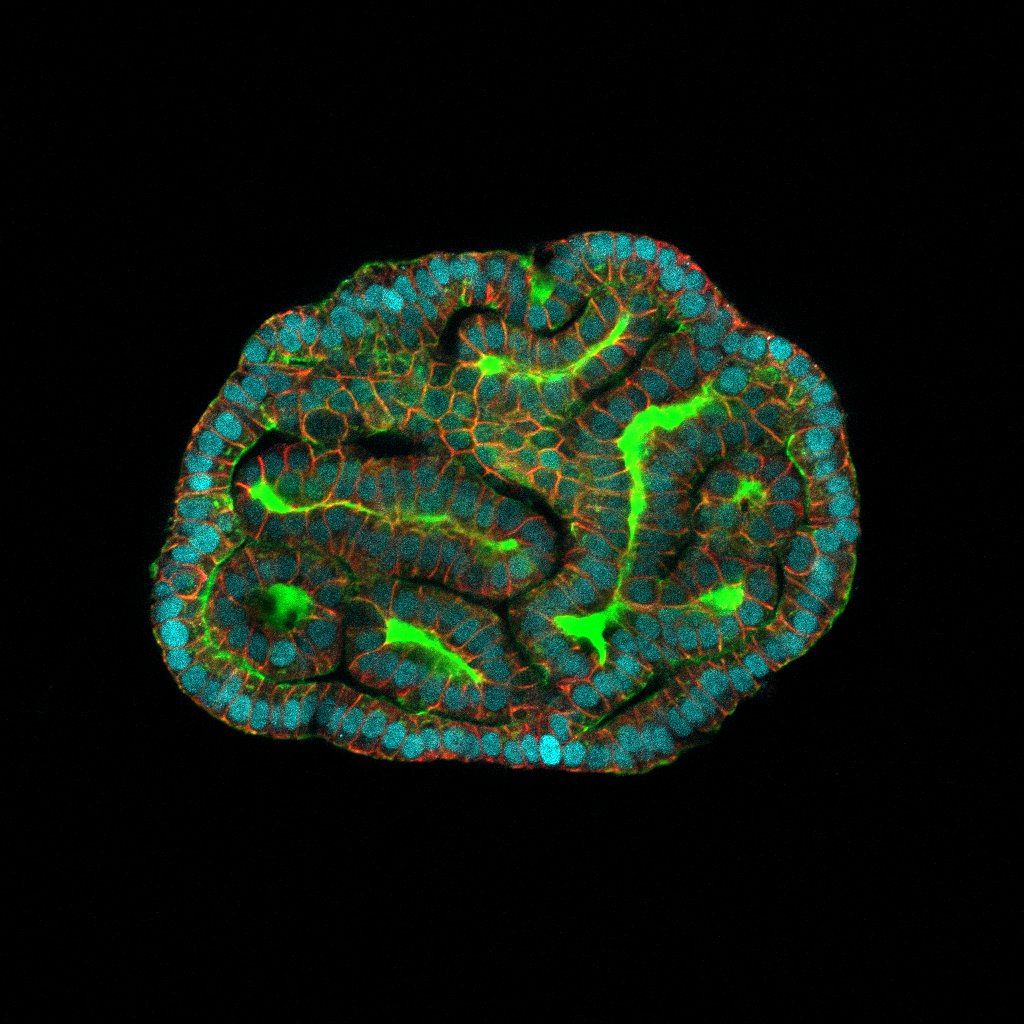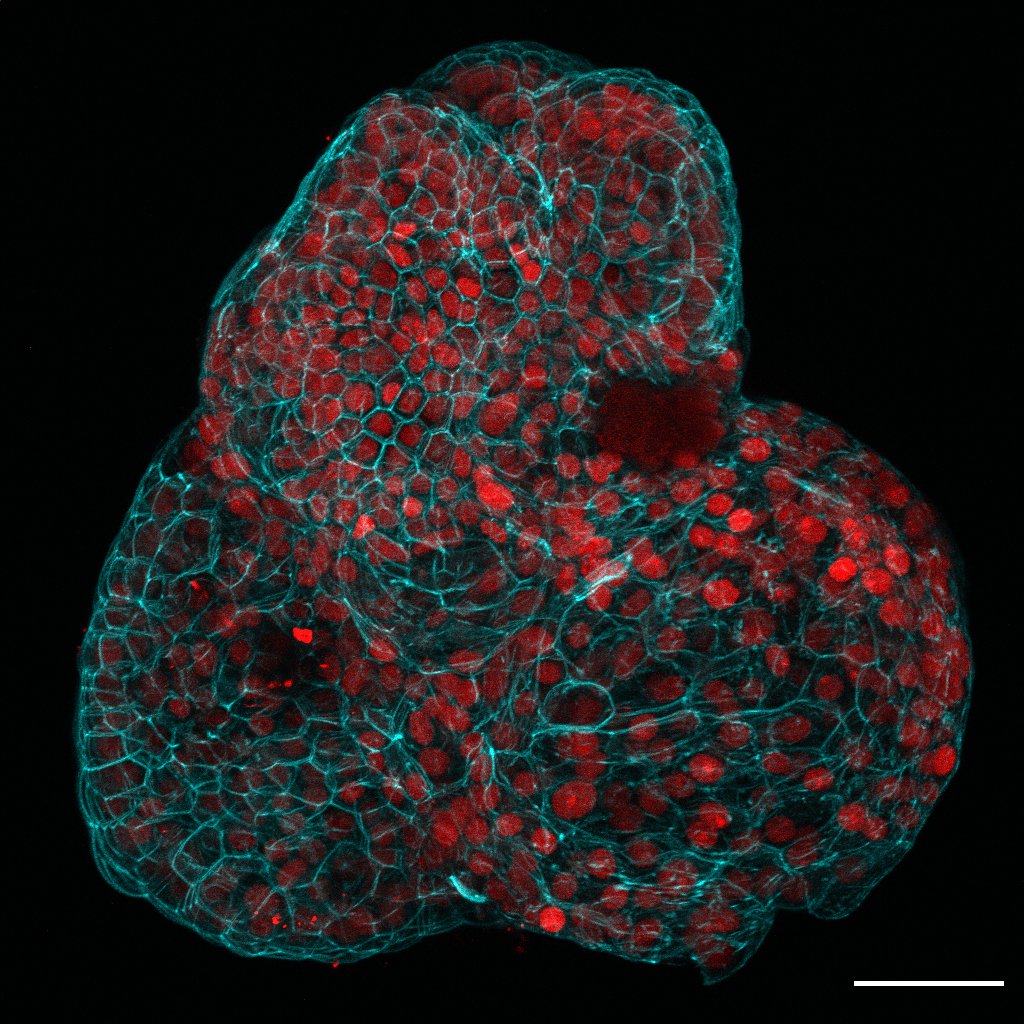
Kidney amniotic fluid organoids resembling renal tubules (Picture: Giuseppe Cala/Paolo di Coppi/Mattia Gerli/PA Wire)
For the first time, ‘mini-organs’ have been grown using human stem cells taken from pregnancy.
Researchers say this could lead to advances in prenatal medicine, as human development can be observed in late pregnancy which could help treat and monitor any congenital conditions before birth.
The mini-organs can retain the baby’s biological information, as the researchers explain these complex cell modules, known as organoids, provide a window for scientists to study how organs function both when they’re healthy and diseased.
Now, scientists will be able to monitor foetal development in late pregnancy and model disease progression as well as test a range of new treatments such as congenital diaphragmatic hernia (CDH).
‘The organoids we created from amniotic fluid cells exhibit many of the functions of the tissues they represent, including gene and protein expression,’ first author Dr Mattia Gerli, at UCL Surgery and Interventional Science, said.
‘They will allow us to study what is happening during development in both health and disease, which is something that hadn’t been possible before.
‘We know so little about late human pregnancy, so it’s incredibly exciting to open up new areas of prenatal medicine.’

The red colouration indicates a lung stem cell marker used to identify the tissue type (Picture: Giuseppe Cala/Paolo di Coppi/Mattia Gerli/PA Wire)
Previously, organs came from adult stem cells, which are usually taken from the bone marrow, as there are restrictions for when foetal samples can be gathered – in the UK it’s up to 22 weeks. For some countries, like the US, foetal sampling is illegal.
But this regulation also means that treating congenital diseases has to be done in a limited timeframe, despite there possibly being an option to treat them after this point.
The researchers at UCL and Great Ormond Street Hospital (GOSH) extracted live cells that passed into the amniotic fluid from 12 pregnancies which were between the 16th week and the 34th week of pregnancy. They then identified which tissues the stem cells came from.
Lungs, kidneys and intestine stem cells were extracted and used to grow the organoids which had the functional features of these tissue types.
The team then collaborated with researchers from KU Leuven in Belgium and looked at the development of babies with CDH – pre and post-treatment – and without to compare the organoids and study the biological characteristics of each group.
CDH is a disease where organs such as the liver and intestine pass through a hole in the diaphragm. Babies with CDH often have underdeveloped lungs, which causes issues with breathing.
All babies with CDH need surgery.
In the UK, around one in 5,000 babies have CDH, and around seven in 10 babies born with CDH will survive.
Stem cells: the lowdown
Stem cells are unique and can develop into many different types of cells such as red blood cells, brain cells and muscle cells.
There are two main forms of stem cells:
- Adult stem cells which come from the brain, skin, and bone marrow – are limited in number and are more likely to create a certain type of cell, such as a stem cell from the liver may only make more liver cells
Adult stem cells could also be induced pluripotent stem cells which are changed in the lab to be more like embryonic stem cells. However, scientists have not yet found one that can develop every kind of cell and tissue.
- The second form is embryonic stem cells which come from unused embryos and are donated to science. They can turn into more than one type of cell.
The study revealed significant developmental differences between healthy and pre-treatment CDH organoids but they also found the organoids in the post-treatment group were much closer to healthy ones – indicating the treatment’s effectiveness at a cellular level.
‘This is the first time that we’ve been able to make a functional assessment of a child’s congenital condition before birth, which is a huge step forward for prenatal medicine,’ said NIHR Professor Paolo de Coppi, senior author of the study.
‘Diagnosis is normally based on imaging such as ultrasound or MRI and genetic analyses.
‘When we meet families with a prenatal diagnosis, we’re often unable to tell them much about the outcome because each case is different.
‘We’re not claiming that we can do that just yet, but the ability to study functional prenatal organoids is the first step towards being able to offer a more detailed prognosis and, hopefully, provide more effective treatments in future.’
The researchers say the method needs to be further studied, but could look at other conditions that affect the lungs – like cystic fibrosis, kidneys and intestine.
Supported by the National Institute for Health and Care Research (NIHR) and Wellcome, the findings are published in Nature Medicine.
Get in touch with our news team by emailing us at [email protected].
For more stories like this, check our news page.
Get your need-to-know latest news, feel-good stories, analysis and more by signing up to Metro’s News Updates newsletter
News Related-
High court unanimously ruled indefinite detention was unlawful while backing preventive regime
-
Cheika set for contract extension as another Wallabies head coaching candidate slips by
-
Analysis-West's de-risking starts to bite China's prospects
-
'Beyond a joke' Labor won't ensure PTSD protections: MP
-
Formula One season driver ratings: Lando Norris shines as Max Verstappen nears perfection
-
Catalina golfer Tony Riches scores Guinness World Record four holes in one on same hole
-
Florida coach Billy Napier fires assistants Sean Spencer, Corey Raymond with expected staff shakeup ahead
-
Rohingyan refugee NZYQ accidentally named in documents published by high court
-
Colorado loses commitments of 2 more high school recruits
-
Queensland Health issues urgent patient safety alert over national bacteria outbreak
-
Townsville Community Pantry 'distressed' by fruit, vegetable waste at Aldi supermarket
-
What Is The Beaver Moon And What Does It Mean For You?
-
Labor senator Pat Dodson to resign from politics due to health issues
-
Hamas releases 11 more hostages, as Israel agrees to extend ceasefire
